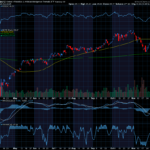Stocks continued their powerful bullish run last week as both the S&P 500 and the Nasdaq indexes each leaped higher to set several new all-time highs! The S&P 500 during Friday’s trading even approached 6300, which would be uncharted territory for the market. This continuation of the bullish momentum was largely powered by several key areas of uncertainty resolving in the market’s favor. Last week we got a few positive stories regarding U.S. trade policy. The first being that Canada decided to drop a ‘digital services tax’ which, one — would have been a damper to U.S. tech stocks and two — was also serving as a major hurdle in negotiations between the U.S. & Canada. Seeing this policy scrapped gave investors’ confidence that a finalized deal with Canada may be coming down the pike soon. Additionally, the framework to a finalized trade deal with Vietnam, a major trading partner of the U.S., was announced which provided further support for stocks. Investors cheered these trade developments as they signaled that the trajectory of U.S. trade policy and negotiations is tracking in the right direction. Building on that, much attention was directed toward Congress as the budget bill (OBBB), was working its way through each chamber. Markets had already been pricing in the expectation that it was going to pass and finally on Thursday by a razor thin margin, this bill passed through Congress and on to be finalized. The key takeaway here is that markets were expecting it to pass and this is the result we got. We avoided any surprises in this process and stocks reacted well because of it. There was one final bullish catalyst last week that drove stocks to the highs of Thursday’s session, and it was the June Job’s report. Headed into this report, investors were quite anxious about what it may reveal about the U.S. labor market, particularly on the heels of a very weak ADP report earlier in the week. To the market’s surprise, the June Job’s report was stronger than expected with more jobs added and even seeing unemployment tick down by two tenths to 4.1%! This very positive jobs report was pretty much the best case scenario given the context, so this new data was able to fuel stocks moving to new highs yet again as it alleviated much angst about the labor market.
After a week in which the S&P 500 set three new all-time closing highs, we need to dive into the market technicals and internals to see what the current setup is telling us and what is most likely to happen in the week to come. Of course, all equity investors rejoice seeing the S&P 500 print new highs day after day. Yet we should all know that stocks cannot just go up day after day until eventually they need to come in a bit and take a breather. Looking at the market technicals following Thursday’s close, I am seeing signs of short-term upside exhaustion according to several indicators that I track closely. Namely the RSI for the S&P 500. As of Thursday, the 5-Day RSI for the S&P is sitting at 90.55. A reading this high is rarely seen on the index and generally serves as an indication of an imminent retracement. The 14-Day RSI also is now overextended for the first time since July ’24. Each of these are reliable tools that tell us that stocks have likely run a bit too far too quickly and are due for a pullback in the week ahead. Of course, this does not mean that we’ll get a pullback immediately, but just to note that conditions in the short term are right for some consolidation. Zooming out, looking at the long term, the market’s trend looks quite strong! We finally got our ‘Golden-Cross’ buy signal last Tuesday, which is a significant bullish technical indication for stocks over the next 12 months. Momentum is still well intact for the S&P and the MACD line is still early in a fresh breakout. Additionally, the Advance/ Decline line for the S&P 500 stocks rose to new highs last week. This is a strong sign of growing breadth in this rally, which is also being corroborated in other data. Now, 78.3% of S&P stocks are above their 50-day MA and 61.2% are above their 200-day MA. These are additional signs that more and more stocks are beginning to participate in this rally, broadening out the base of strength. So, to summarize, it is my view that in the medium to long term, stocks are in a very good place currently as we are seeing some very constructive trends forming. That said, at current price levels, in the short term I am fully expecting stocks to ‘cool down’ a bit in the next week or so because according to the technicals we are a bit stretched at the moment. I’m anticipating a small pullback likely toward the middle Keltner channel as we head into Q2 earnings season and then significant earnings results will determine our path beyond that.
🚨📈 My WPO Newsletter recently gave my members the chance at a 117.4% profit opportunity in just a few weeks. Of course not all recommendations work out this well but if you want to receive the next alert, go ahead and Click Here to begin your trial for JUST $1 Today! 📈🚨

This market is fast and furious and getting insight as it happens is key to trading success. To give you live market insight we are launching Trade of the Day LIVE. Click here to sign up for the next live room and make sure you are there.
Key Events to Watch For
- U.S. Trade Policy | July 9th Deadline
- Initial Jobless Claims
- Q2 Earnings Begin (DAL)
As investors look to build on a week in which stocks made numerous new all-time highs, the area of concern that will likely draw the most attention this week will be U.S. Trade policy, particularly the quickly approaching July 9th deadline. This is the date when the 90-day pause in the Administration’s ‘reciprocal’ tariffs is set to expire. Now, markets are not currently pricing in a hiccup here as investors seem to think either significant deals will be in progress by then or the pause will be extended. However, should the market be dealt a surprise related to this issue, say the April reciprocal tariffs being put back into place on a major trading partner, this would likely be enough to knock stocks off their current path. On the other hand, should any new trade deals with significant partners be announced, expect markets to react favorably to this news. This seems like a week where stocks are likely going to be captive to headlines whether good or bad. So, make sure to keep an eye on this date as any development could prove critical.
In the macroeconomic realm, this upcoming week is relatively quiet as not too much new data is expected. There is one report that will likely continue to garner some attention and that is the weekly Initial Jobless claims report. Per usual, this report will be revealed on Thursday morning, prior to the market open. Lately this report has been receiving a bit more attention than usual because initial claims have begun to trend a bit higher, potentially signaling some labor market weakness. They had not risen to ultra-concerning levels but were high enough to merit a second glance with the 4-week average reaching 245K. But in the past two weeks, this number has reversed, trending lower, below 240K. This week, economists are expecting 235K initial claims, which if the report meets this number or beats to the downside, then this leading labor market indicator will not cause much upset for investors. It’s been good to see this report move in the right direction in the last two weeks. Couple this with the stronger than expected June Jobs report from last week, if the data continues to signal strength in the labor market, then this will provide further support for stocks.
The last few weeks have been quiet on the earnings front as Q1 earnings season wrapped up a while back, however, the earnings bonanza is just about ready to rev back up. This week we will get the first Q2 earnings report that will hold any real significance for the market. On Thursday, before the opening bell, Delta Air Lines, Inc., symbol: DAL, will report their latest quarterly results. Wall St. is expecting for DAL to actually report Q2 earnings that are about 13% lower YoY. DAL stock is of course not significant to the market due to its market cap size or ability to swing the indexes based on its price movement, it has little relevance here. However, where DAL does hold some significance which is more important to broader markets is that their financial results and earnings are a window in the U.S. consumer, particularly to the upper middle to upper class consumer. DAL’s results are reflective of this demographic’s spending behavior. So, expect investors to parse the results closely for any read-throughs into the U.S. consumer.
Thank you for reading this week’s edition of the Weekly Market Periscope Newsletter, I hope you enjoyed it. Please lookout out for the next edition of the newsletter as we will give you a preview of the upcoming week’s important market events.
Thanks,
Blane Markham
Author, Weekly Market Periscope
Hughes Optioneering Team












Recent Comments